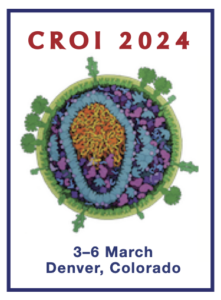CROI 2024: Studies using tecovirimat to treat mpox
16 March 2024. Related: Conference reports, mpox, CROI 31 Denver 2024.
Simon Collins, HIV i-Base
 Although tecovirimat is recommended as a treatment for severe or complex mpox infection, clinical evidence is largely from observational studies, as randomised controlled studies such as the ACTG STOMP study have been delayed by the falling cases.
Although tecovirimat is recommended as a treatment for severe or complex mpox infection, clinical evidence is largely from observational studies, as randomised controlled studies such as the ACTG STOMP study have been delayed by the falling cases.
Five studies at CROI 2024 reported on the use of the tecovirimat.
The clearest data on potential efficacy in people living with HIV was reported in a matched case-control study from Atlanta that matched 56 people who started tecovirimat within seven days of first symptoms to 56 who either started tecovirimat later or not at all. Matching included by age (mean 35 yo), race (85% Black), HIV viral load <200 copies/mL (59%), no mucosal sites at presentation (38%), and hospitalisation at day 7 (26%). Early vs late treatment was associated with mpox progression in 3 (5%) vs 13 (23%) individuals [paired OR: 11.0 (95% CI: 1.4 to 85.1), p=0.006]. [1]
Another study reported predictors of responding to tecovirimat in 382 men living with HIV in the US, diagnosed with mpox between June to December 2022. Roughly 5% (n=25) had a CD4 count <200 cells/mm3 and 12% (n=47) had a CD4 count between 200 to 350 cells/mm3. Most of this cohort (96%) were on ART, but 20% had detectable viral load. Just over 40% (n=163) used tecovirimat. Also, 13% of cases had received at least one dose of JYNNEOS mpox vaccine before diagnosis.
Those not on ART were approximately four times more likely to be hospitalised which was also associated with having a lower CD4 count. A low CD4 count doubled the chance of getting tecovirimat. Race/ethnicity, detectable HIV viral load, and ART status were not associated with receiving tecovirimat.
Two other posters at the conference presented case notes on small numbers of men living with HIV who also had advanced mpox.
Two cases of tecovirimat use in people who were both HIV positive included the development of resistance to tecovirimat in one. This person had a CD4 count of 43 cells/mm3, viral load >30,000 copies/mL and BMI 48.5 kg/m2. Although symptoms improved on treatment, new lesions occurred within three days of stopping tecovirimat with mutations A290V, D294V, I372N and Y252C. [3]
Another poster presented retrospective results from using tecovirimat with cidofovir, presented in four men with advanced mpox from Philadelphia. Age ranged from 30s to 50s, CD4 count from 0 to 53 cells/mm3 and viral load from 2,000 to 217,000 copies/mL. [4]
Early tecovirimat was not reported to have a significant response compared to the impact from ART and cidofovir. One person recovered fully after a single 6-week course of tecovirimat with 6 doses of cidofovir and ART. The other three were more complicated by difficult adherence to ART and food and housing insecurity. These required extended tecovirimat (5 to 16 weeks) and cidofovir (1 to 12 doses). Ocular lesions were treated with trifluridine (3 weeks).
After ART, all cases had markedly lower HIV load (0-138 copies/ml), with improved mpox lesions at follow-up and stable renal function.
Finally a PK substudy in 13 participants in the open-label arm of the STOMP study reported lower drug levels in HIV positive compared to negative participants, but all levels still stayed above the minimal effective levels determined in macaques. Oral tecovirimat was given at 600 mg, twice-daily. [5]
Of the 13 participants, 11 were adult men, with one pregnant woman and one adolescent. Of the 7/13 who were living with HIV, 2/7 were not on ART and had CD4 <200 cells/mm3.
Median tecovirimat AUC (0-12 hrs) and Cmin (at 12 hr) were 38% and 72% lower, respectively, in HIV positive vs negative participants. However, the Cmin still remained higher in all participants than minimal effective concentrations established in monkey studies.
The open-label cohort was for people with severe mpox, immunosuppression, pregnancy and those aged <18 years, when randomisation to a placebo control arm would not have been ethical. Results from the randomised arms of STOMP are still awaited.
References
- Aldred B et al. Early tecovirimat treatment for mpox disease among people with HIV: a matched cohort analysis. CROI 2024, Denver, USA. Posterabstract 419.
https://www.croiconference.org/abstract/early-tecovirimat-treatment-for-mpox-disease-among-people-with-hiv-a-matched-cohort-analysis/ - Montano M et al. Predictors of treatment with tecovirimat and hospitalization among people with mpox and HIV. CROI 2024, Denver, USA. Poster abstract 423.
https://www.croiconference.org/abstract/predictors-of-treatment-with-tecovirimat-and-hospitalization-among-people-with-mpox-and-hiv/ - Marot S et al. Tecovirimat plasma concentrations, mpox resistance mutations selection, and clinical outcomes. CROI 2024, Denver, USA. Poster abstract 422.
https://www.croiconference.org/abstract/tecovirimat-plasma-concentrations-mpox-resistance-mutations-selection-and-clinical-outcomes/ - Duong MT et al. Combination of extended antivirals with antiretrovirals for severe mpox in advanced HIV infection. CROI 2024, Denver, USA. Poster abstract 420.
https://www.croiconference.org/abstract/combination-of-extended-antivirals-with-antiretrovirals-for-severe-mpox-in-advanced-hiv-infection/ - Wei Z et al. Pharmacokinetics of tecovirimat in persons with mpox: results from ACTG 5418. CROI 2024, Denver, USA. Poster abstract 428.
https://www.croiconference.org/abstract/pharmacokinetics-of-tecovirimat-in-persons-with-mpox-results-from-actg-5418/

